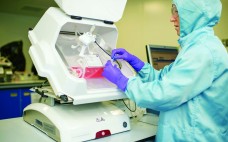Introduction by Cheryl Scott The CMC Strategy Forum series provides a venue for biopharmaceutical product discussion. The meetings focus on relevant chemistry, manufacturing, and controls (CMC) issues throughout the life cycle of a therapeutic and thereby foster collaborative technical and regulatory interaction. Forum chairs share information with regulatory agencies to help them merge good scientific and regulatory practices. Outcomes of the forum meetings are published in BioProcess International. This process is meant to help ensure that biopharmaceutical products manufactured with…
2015
Perfusion’s Role in Maintenance of High-Density T-Cell Cultures
T-cell therapy is a rapidly growing field of personalized medicine, attracting the interest of venture capitalists and pharmaceutical companies alike. Such therapies exploit T cells’ innate abilities to protect against pathogens as well as to seek and destroy cancerous cells. Although many different forms of T-cell therapies are currently in clinical trials, they all follow a common protocol: T cells are isolated from a patient, modified and expanded in a laboratory setting, and then infused back into the same patient…
Bioreactor Design for Adherent Cell Culture — The Bolt-On Bioreactor Project, Part 1: Volumetric Productivity
The Bolt-on Bioreactor (BoB) project is an independent initiative aimed at developing and commercializing a bioreactor for efficient, automated culture of adherent cells in production of therapeutic cells and other biopharmaceuticals (1). After conducting thorough research on available culture systems for adherent cells, the BoB team believes that a successful alternative to existing devices must solve four major challenges. The first challenge has to do with volumetric productivity, the second with process automation, the third with containment and sterility, and…
Evaluating Freeze–Thaw Processes in Biopharmaceutical Development – Small-Scale Study Designs
Regulations mandate that biopharmaceutical product quality be controlled throughout manufacturing, storage, transportation, and delivery to patients (1). Operations often include freezing and thawing of a bulk drug substance, dilution of that purified substance to a target concentration, filtration, filling into a selected container–closure system, additional processing (e.g., lyophilization), inspection, packaging, storage, transport, and delivery (2). Freezing is a common processing step used to maintain stability and quality of a drug substance during development and production of biopharmaceutical products. It is…
Recruiting and Market Share Reshape Life Sciences Facilities and Locations
Where a biopharmaceutical company does business affects its profitability — as does how it manages its facilities and even where its non–customer-facing operations are located. In fact, facilities and real estate represent some of the biggest expenses for such companies. And yet, they are often overlooked. In today’s shifting global life-sciences landscape, site selection and management strategies are coming to the forefront as companies seek operating efficiencies, access to multidisciplinary talent, and cost-effective facilities. The following insights from JLL’s 2014…




